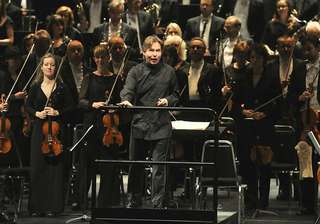|
Back
Composers in Elegant Dress New York
David Geffen Hall, Lincoln Center
02/08/2023 - & February 9, 10, 11, 2023
Luciano Berio: Four Original Versions of Boccherini’s “Ritirata notturna di Madrid”
Esa-Pekka Salonen: Kínēma
Ludwig van Beethoven: Symphony No.7, Op.92
Anthony McGill (Clarinet)
New York Philharmonic Orchestra, Esa-Pekka Salonen (Conductor)

E.‑P. Salonen (© Peg Skorpinski)
“Anyone who composes and conducts at the same time is immediately suspect, because he must be faking one or the other.”
Esa-Pekka Salonen
Take two composers reputed for their rarefied elaborate creations. Then preclude their difficulties, dress up their music with the clothes of dignified gentlemen, men with a sense of humor and pure likeability, and what have you got?
The first half of tonight’s New York Philharmonic concert, under the exuberant leadership of Esa‑Pekka Salonen.
The first work had been a 1780 remake with a Marx Brothers‑style title, A Night in Madrid. That original was a splendid walk through the Spanish capital during the late 18th Century. Church bells ringing, soldiers marching, people singing, horses prancing. Boccherini caught it all, first as part of a string quartet and later–due its popularity–into three or four different arrangements.
So more than two centuries later, Luciano Berio rewrote the original into a work for full orchestra. In this case, the entire parade of nocturnal Spaniards came to life. First from far away (the Phil’s violins whispering), then closer, and then–with the Spanish militia blasting out its merriment–with fortissimo grandeur. Before disappearing into the night.
Mendelssohn (and others) had composed this spatial illusion in his Fourth Symphony. And this seven‑minute piece from both Boccherini and Berio was equally grand. Esa‑Pekka Salonen treated it literally as a graphic ceremony. Nothing exaggerated, nothing contrived, a treatment with proportion and dimension.

A. McGill (© New York Philharmonic)
Despite Mr. Salonen’s modest words above, he conducted his Kínēma with measured gravity, helped to an infinite degree by the Phil’s First Chair clarinetist, Anthony McGill.
Whatever criticism this orchestra may endure, nobody has ever questioned the esteem of their First Chair players, Mr. McGill among them. He was the soloist with the string orchestra in Kínēma, and offered music of lucid beauty. Mr. McGill’s sheer technical brilliance was not shown until the third movement, “Pérotin dream,” but after that, there was no stopping him.
Yet composer Salonen had not written a virtuoso concerto for clarinet. Instead, Kínēma was, in his words, “Material developed from film scores.” (Thus the title.) “Most of it is very lyrical, and you might imagine a romantic film.”
Point taken. The opening “Dawn” was soft, moody. Except for a few dissonances, it could have been composed by Delius. The following “Theme and variations” resembled a short story, each movement a different character.
The “Pérotin” movement was less based on the jaunty 12th Century contrapuntalist as a free-wheeling essay for the soloist. This was followed by an elegy, perhaps the only seriously tragic section. The finale used a few of the “Dawn” themes. The composer said this might have resembled the repetitions used by Anton Bruckner. But instead, this recapitulation was indeed like a classical movie scenario, where the twisted plot lines were untangled.
The result was a work of elegant texture, unproblematic (except for Mr. McGill, who handled it well) and an image of Mr. Salonen’s personal Arcadia.
After the intermission, Mr. Salonen made up for the whispers of Boccherini and the strings of his own Kínēma with a terrific blasting-brass, booming timpani and a second movement which balanced out his funereal dirge. This Beethoven Seventh was not subtle, nor was this “symphony of the dance” (Wagner’s words, not mine) meant to be.
Forget the percussive thunder and brassy lightning. This was an enlightened reading. Using all the repeats, nothing was either wrong or long in three of the movements. Oh, the Presto movement was so fast that some of the notes were dropped. Yet it still danced merrily along.
As for that second movement, a piece that is usually mysterious, sanguine and often tragic, Mr. Salonen’s own version was not deeply into tragedy, it was taken briskly–and was so much part of this vigorous reading that one realized it was part of Mr. Salonen’s so vibrant declaration.
Harry Rolnick
|